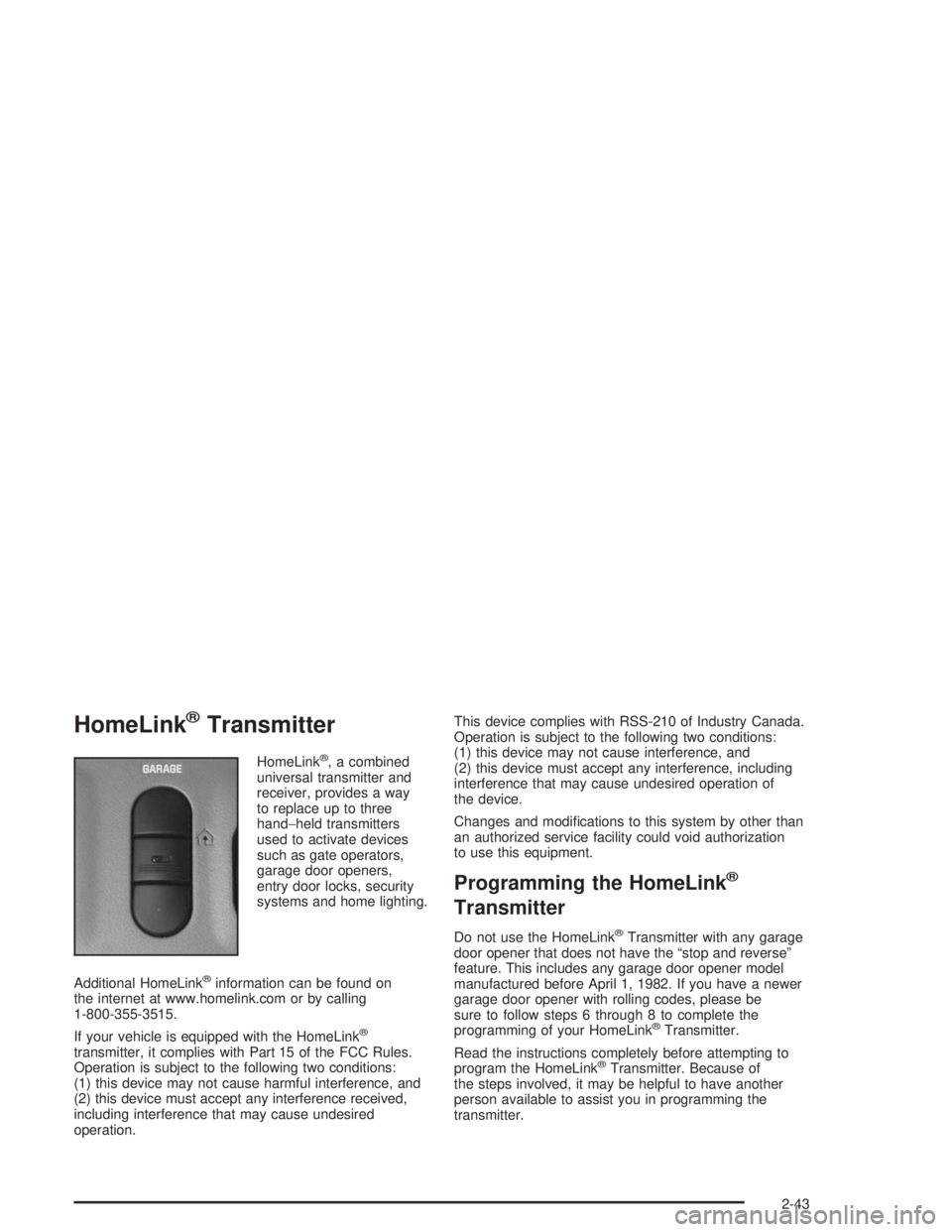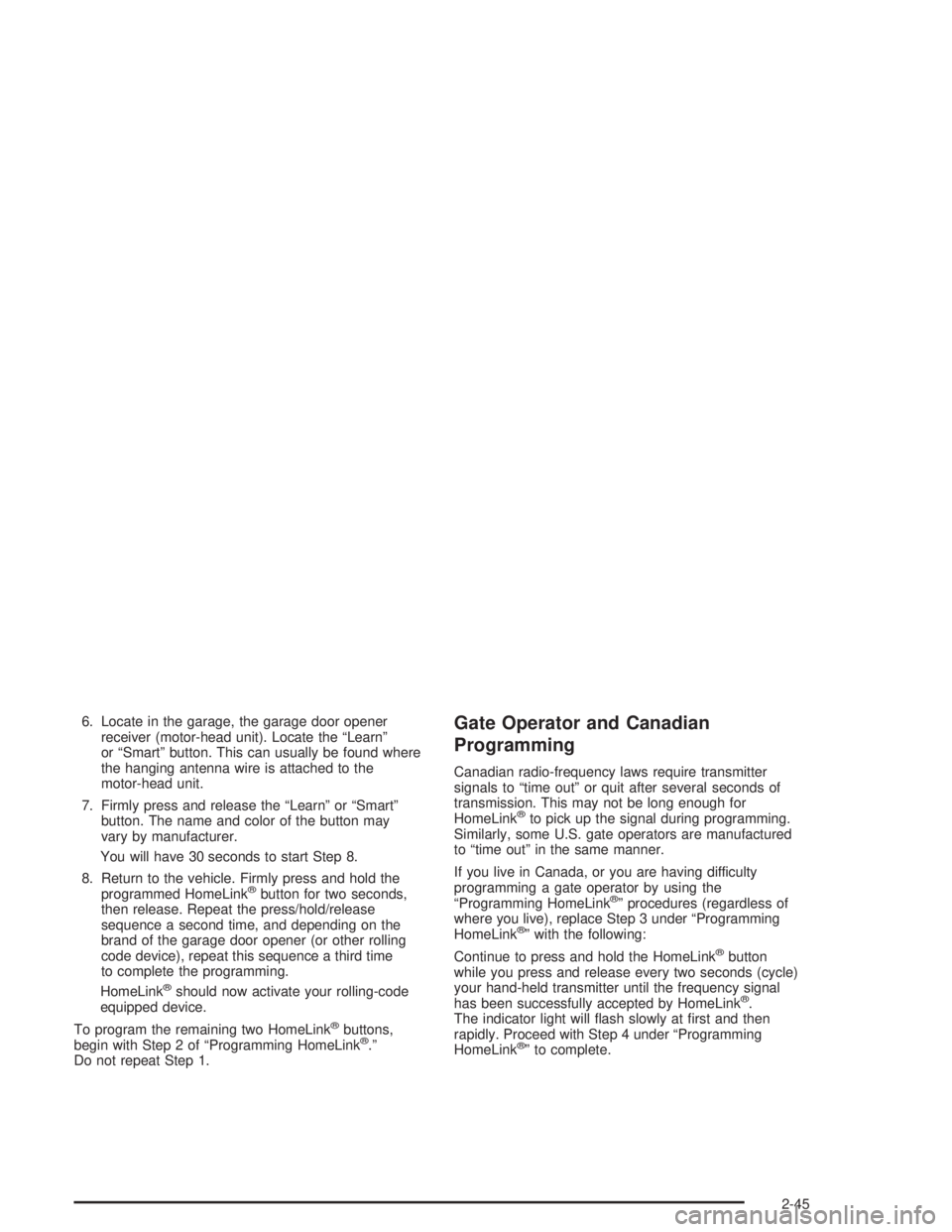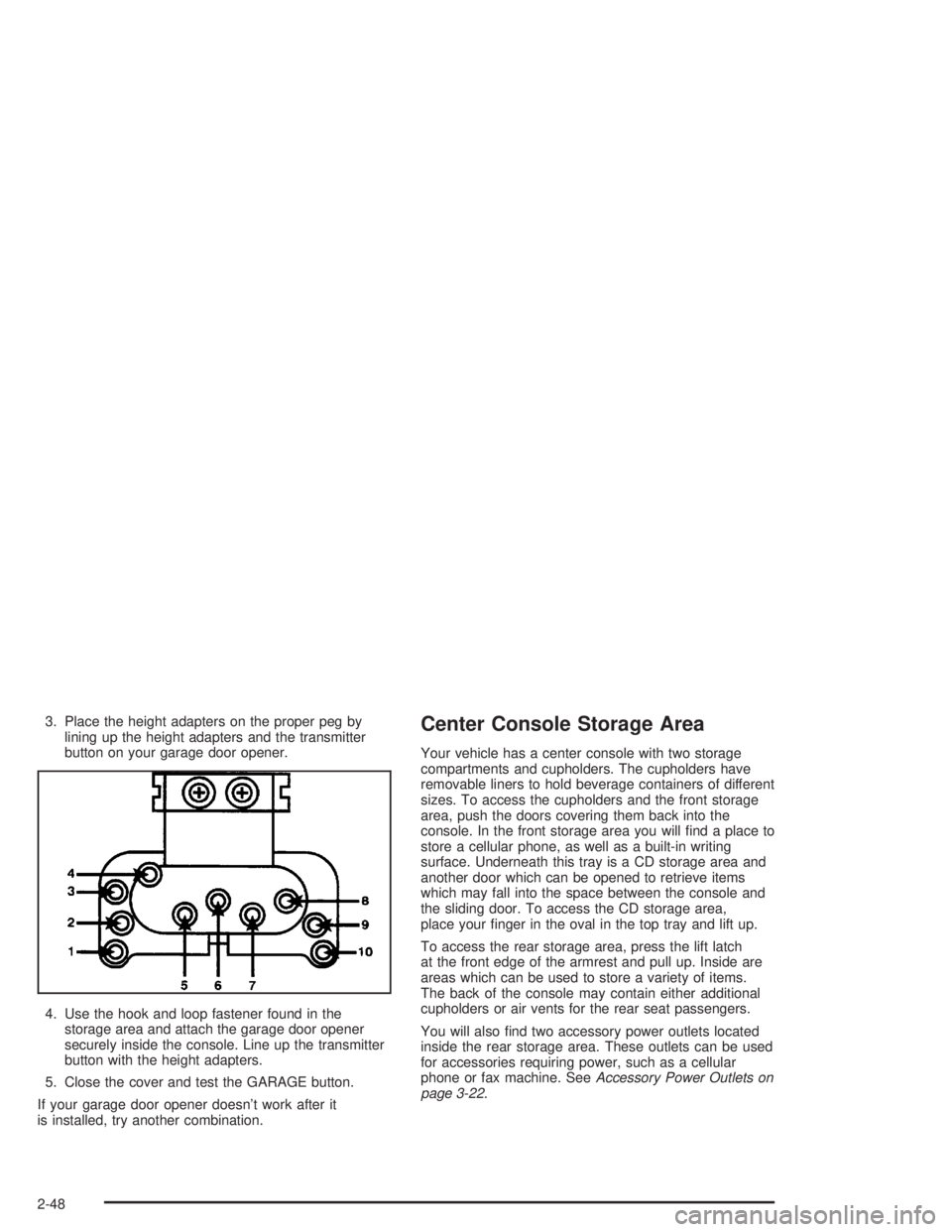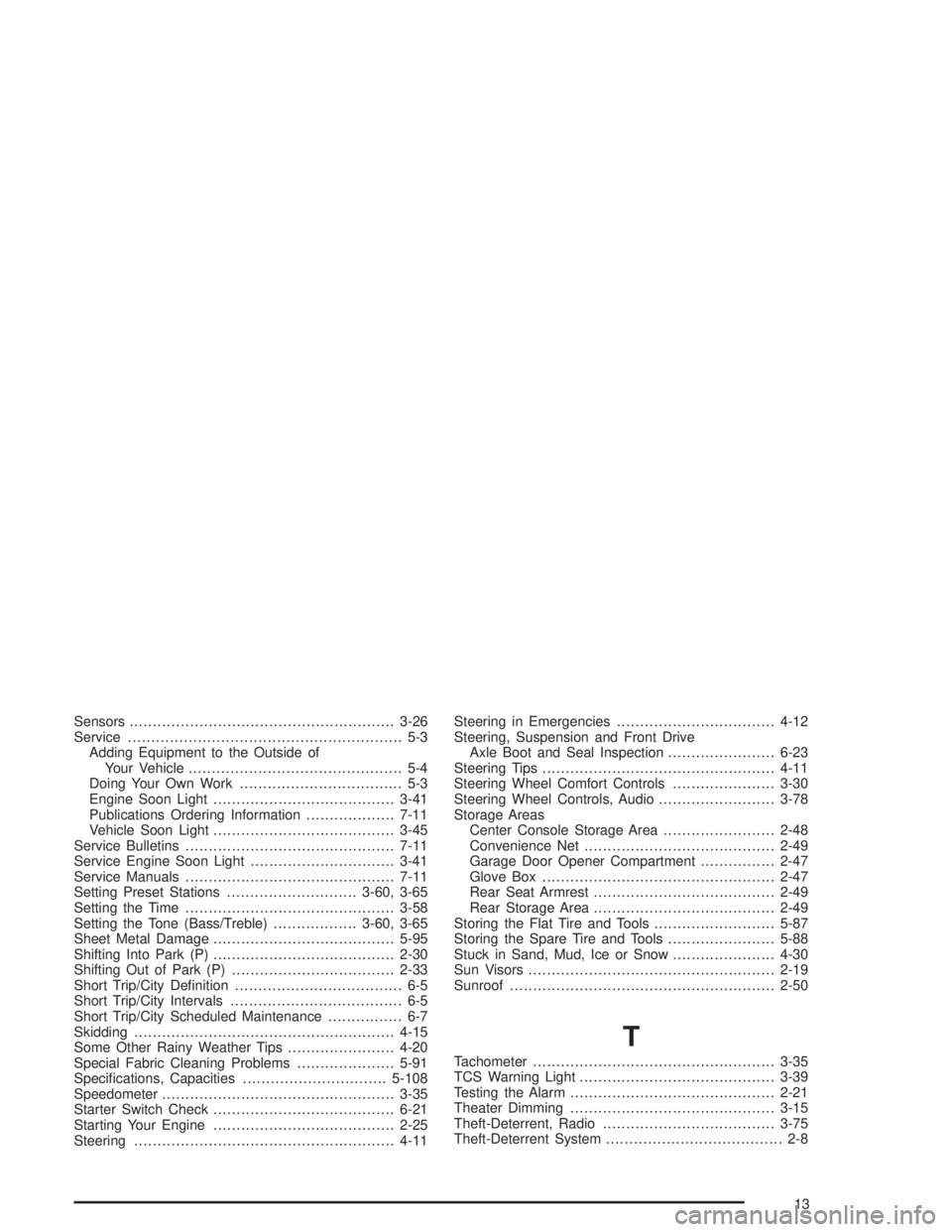2004 BUICK PARK AVENUE garage door opener
[x] Cancel search: garage door openerPage 68 of 410

OnStar®System.............................................2-41
HomeLink®Transmitter...................................2-43
Programming the HomeLink®Transmitter.........2-43
Storage Areas................................................2-47
Glove Box...................................................2-47
Garage Door Opener Compartment.................2-47
Center Console Storage Area.........................2-48
Assist Handles.............................................2-49Rear Storage Area........................................2-49
Rear Seat Armrest........................................2-49
Rear Seat Pass Through...............................2-49
Convenience Net..........................................2-49
Sunroof.........................................................2-50
Vehicle Personalization...................................2-51
Memory Seat and Mirrors..............................2-51
Section 2 Features and Controls
2-2
Page 109 of 410

HomeLink®Transmitter
HomeLink®, a combined
universal transmitter and
receiver, provides a way
to replace up to three
hand−held transmitters
used to activate devices
such as gate operators,
garage door openers,
entry door locks, security
systems and home lighting.
Additional HomeLink
®information can be found on
the internet at www.homelink.com or by calling
1-800-355-3515.
If your vehicle is equipped with the HomeLink
®
transmitter, it complies with Part 15 of the FCC Rules.
Operation is subject to the following two conditions:
(1) this device may not cause harmful interference, and
(2) this device must accept any interference received,
including interference that may cause undesired
operation.This device complies with RSS-210 of Industry Canada.
Operation is subject to the following two conditions:
(1) this device may not cause interference, and
(2) this device must accept any interference, including
interference that may cause undesired operation of
the device.
Changes and modi�cations to this system by other than
an authorized service facility could void authorization
to use this equipment.
Programming the HomeLink®
Transmitter
Do not use the HomeLink®Transmitter with any garage
door opener that does not have the “stop and reverse”
feature. This includes any garage door opener model
manufactured before April 1, 1982. If you have a newer
garage door opener with rolling codes, please be
sure to follow steps 6 through 8 to complete the
programming of your HomeLink
®Transmitter.
Read the instructions completely before attempting to
program the HomeLink
®Transmitter. Because of
the steps involved, it may be helpful to have another
person available to assist you in programming the
transmitter.
2-43
Page 110 of 410

Keep the original transmitter for use in other vehicles as
well as for future HomeLink®programming. It is also
recommended that upon the sale of the vehicle, the
programmed HomeLink
®buttons should be erased for
security purposes. Refer to “Erasing HomeLink®Buttons”
or, for assistance, contact HomeLink®on the internet at:
www.homelink.com or by calling 1-800-355-3515.
Be sure that people and objects are clear of the
garage door or gate operator you are programming.
When programming a garage door, it is advised to
park outside of the garage.
It is recommended that a new battery be installed in
your hand-held transmitter for quicker and more
accurate transmission of the radio frequency.
Your vehicle’s engine should be turned off while
programming the transmitter. Follow these steps to
program up to three channels:
1. Press and hold down the two outside buttons,
releasing only when the indicator light begins to
�ash, after 20 seconds. Do not hold down the
buttons for longer than 30 seconds and do not
repeat this step to program a second and/or third
transmitter to the remaining two HomeLink
®buttons.
2. Position the end of your hand-held transmitter about
1 to 3 inches (3 to 8 cm) away from the HomeLink
®
buttons while keeping the indicator light in view.3. Simultaneously press and hold both the desired
button on HomeLink
®and the hand-held transmitter
button. Do not release the buttons until Step 4
has been completed.
Some entry gates and garage door openers may
require you to substitute Step 3 with the procedure
noted in “Gate Operator and Canadian
Programming” later in this section.
4. The indicator light will �ash slowly at �rst and then
rapidly after HomeLink
®successfully receives the
frequency signal from the hand-held transmitter.
Release both buttons.
5. Press and hold the newly-trained HomeLink
®button
and observe the indicator light.
If the indicator light stays on constantly, programming
is complete and your device should activate when the
HomeLink
®button is pressed and released.
To program the remaining two HomeLink®buttons,
begin with Step 2 under “Programming HomeLink®.”
Do not repeat Step 1 as this will erase all of the
programmed channels.
If the indicator light blinks rapidly for two seconds
and then turns to a constant light, continue with
Steps 6 through 8 following to complete the
programming of a rolling-code equipped device
(most commonly, a garage door opener).
2-44
Page 111 of 410

6. Locate in the garage, the garage door opener
receiver (motor-head unit). Locate the “Learn”
or “Smart” button. This can usually be found where
the hanging antenna wire is attached to the
motor-head unit.
7. Firmly press and release the “Learn” or “Smart”
button. The name and color of the button may
vary by manufacturer.
You will have 30 seconds to start Step 8.
8. Return to the vehicle. Firmly press and hold the
programmed HomeLink
®button for two seconds,
then release. Repeat the press/hold/release
sequence a second time, and depending on the
brand of the garage door opener (or other rolling
code device), repeat this sequence a third time
to complete the programming.
HomeLink
®should now activate your rolling-code
equipped device.
To program the remaining two HomeLink
®buttons,
begin with Step 2 of “Programming HomeLink®.”
Do not repeat Step 1.
Gate Operator and Canadian
Programming
Canadian radio-frequency laws require transmitter
signals to “time out” or quit after several seconds of
transmission. This may not be long enough for
HomeLink
®to pick up the signal during programming.
Similarly, some U.S. gate operators are manufactured
to “time out” in the same manner.
If you live in Canada, or you are having difficulty
programming a gate operator by using the
“Programming HomeLink
®” procedures (regardless of
where you live), replace Step 3 under “Programming
HomeLink
®” with the following:
Continue to press and hold the HomeLink
®button
while you press and release every two seconds (cycle)
your hand-held transmitter until the frequency signal
has been successfully accepted by HomeLink
®.
The indicator light will �ash slowly at �rst and then
rapidly. Proceed with Step 4 under “Programming
HomeLink
®” to complete.
2-45
Page 113 of 410

Storage Areas
Glove Box
Use the key to lock and unlock the glove box. To open the
glove box, pull the handle upward until the latch opens.
Garage Door Opener Compartment
If your vehicle has this feature, the garage door opener
storage area is located in the headliner near the
front reading lamps.To install your garage door opener, do the following:
1. Push the extended tab above the GARAGE button
or insert a tool between the tab and outer edge of
the cover. The garage door opener cover will
�ip down.
2. Remove the square height adapters from the cover.
2-47
Page 114 of 410

3. Place the height adapters on the proper peg by
lining up the height adapters and the transmitter
button on your garage door opener.
4. Use the hook and loop fastener found in the
storage area and attach the garage door opener
securely inside the console. Line up the transmitter
button with the height adapters.
5. Close the cover and test the GARAGE button.
If your garage door opener doesn’t work after it
is installed, try another combination.Center Console Storage Area
Your vehicle has a center console with two storage
compartments and cupholders. The cupholders have
removable liners to hold beverage containers of different
sizes. To access the cupholders and the front storage
area, push the doors covering them back into the
console. In the front storage area you will �nd a place to
store a cellular phone, as well as a built-in writing
surface. Underneath this tray is a CD storage area and
another door which can be opened to retrieve items
which may fall into the space between the console and
the sliding door. To access the CD storage area,
place your �nger in the oval in the top tray and lift up.
To access the rear storage area, press the lift latch
at the front edge of the armrest and pull up. Inside are
areas which can be used to store a variety of items.
The back of the console may contain either additional
cupholders or air vents for the rear seat passengers.
You will also �nd two accessory power outlets located
inside the rear storage area. These outlets can be used
for accessories requiring power, such as a cellular
phone or fax machine. SeeAccessory Power Outlets on
page 3-22.
2-48
Page 400 of 410

Fuel (cont.)
Fuels in Foreign Countries.............................. 5-6
Gage.........................................................3-46
Gasoline Octane........................................... 5-4
Gasoline Speci�cations.................................. 5-5
System Inspection.......................................6-24
FUEL INFO (Information).................................3-48
Fuses
Fuses and Circuit Breakers...........................5-99
G
Gage
Engine Coolant Temperature.........................3-40
Fuel..........................................................3-46
Speedometer..............................................3-35
Tachometer.................................................3-35
GAGE INFO (Information)................................3-48
Garage Door Opener.......................................2-43
Garage Door Opener Compartment...................2-47
Gasoline
Octane........................................................ 5-4
Speci�cations............................................... 5-5
Gate Operator and Canadian Programming........2-45
Glove Box.....................................................2-47
Glove Box Lamp.............................................3-18
GM Mobility Program for Persons with
Disabilities.................................................... 7-5
H
Hazard Warning Flashers................................... 3-4
Head Restraints............................................... 1-5
Headlamp
Aiming.......................................................5-49
Headlamp High/Low-Beam Changer.................... 3-7
Headlamps....................................................5-51
Bulb Replacement.......................................5-51
Front Turn Signal Lamps..............................5-54
Halogen Bulbs............................................5-51
Headlamps On Reminder.................................3-13
Head-Up Display (HUD)...................................3-18
Heated Backlite Antenna..................................3-80
Heated Seats................................................... 1-3
Highway Hypnosis...........................................4-24
Hill and Mountain Roads..................................4-24
Hitches..........................................................4-41
HomeLink
®Transmitter....................................2-43
HomeLink®Transmitter, Programming................2-43
Hood
Checking Things Under................................5-10
Release.....................................................5-10
Horn............................................................... 3-5
How the System Works...................................3-21
How to Add Coolant to the Coolant
Recovery Tank............................................5-32
How to Add Coolant to the Radiator..................5-34
How to Add Fluid............................................5-25
6
Page 407 of 410

Sensors.........................................................3-26
Service........................................................... 5-3
Adding Equipment to the Outside of
Your Vehicle.............................................. 5-4
Doing Your Own Work................................... 5-3
Engine Soon Light.......................................3-41
Publications Ordering Information...................7-11
Vehicle Soon Light.......................................3-45
Service Bulletins.............................................7-11
Service Engine Soon Light...............................3-41
Service Manuals.............................................7-11
Setting Preset Stations............................3-60, 3-65
Setting the Time.............................................3-58
Setting the Tone (Bass/Treble)..................3-60, 3-65
Sheet Metal Damage.......................................5-95
Shifting Into Park (P).......................................2-30
Shifting Out of Park (P)...................................2-33
Short Trip/City De�nition.................................... 6-5
Short Trip/City Intervals..................................... 6-5
Short Trip/City Scheduled Maintenance................ 6-7
Skidding........................................................4-15
Some Other Rainy Weather Tips.......................4-20
Special Fabric Cleaning Problems.....................5-91
Speci�cations, Capacities...............................5-108
Speedometer..................................................3-35
Starter Switch Check.......................................6-21
Starting Your Engine.......................................2-25
Steering........................................................4-11Steering in Emergencies..................................4-12
Steering, Suspension and Front Drive
Axle Boot and Seal Inspection.......................6-23
Steering Tips..................................................4-11
Steering Wheel Comfort Controls......................3-30
Steering Wheel Controls, Audio.........................3-78
Storage Areas
Center Console Storage Area........................2-48
Convenience Net.........................................2-49
Garage Door Opener Compartment................2-47
Glove Box..................................................2-47
Rear Seat Armrest.......................................2-49
Rear Storage Area.......................................2-49
Storing the Flat Tire and Tools..........................5-87
Storing the Spare Tire and Tools.......................5-88
Stuck in Sand, Mud, Ice or Snow......................4-30
Sun Visors.....................................................2-19
Sunroof.........................................................2-50
T
Tachometer....................................................3-35
TCS Warning Light..........................................3-39
Testing the Alarm............................................2-21
Theater Dimming............................................3-15
Theft-Deterrent, Radio.....................................3-75
Theft-Deterrent System...................................... 2-8
13